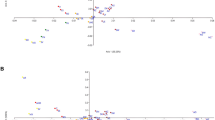Summary
Deficiency in hepatic tyrosine aminotransferase (TAT) causes tyrosinemia type II, an autosomal recessively inherited disorder. Using a TAT cosmid clone, we have identified an MspI restriction fragment length polymorphism (RFLP) 5′ to the TAT gene, with allele frequencies of 0.63 and 0.37. Analysis of the cloned maternal and paternal TAT alleles from patient with tyrosinemia type II led to the identification of a HaeIII RFLP at the 3′ end of the TAT gene, with allele frequencies of 0.94 and 0.06. The two RFLPs are 27 kb apart and in no allelic association. From haplotype frequencies, a polymorphism information content (PIC) value of 0.44 was obtained. The two RFLPs have allowed the unambiguous identification of the mutant TAT alleles in the patient's pedigree by haplotype analysis.
Similar content being viewed by others
References
Andersson SM, Räihä NCR, Ohisalo JJ (1980) Tyrosine aminotransferase activity in human fetal liver. J Dev Physiol 2:17–27
Baas F, Bikker H, Van Ommen GJB, Vijlder JJM de (1984) Unusual scarcity of restriction site polymorphism in the human thyroglobulin gene. A linkage study suggesting autosomal dominance of a defective thyroglobulin allele. Hum Genet 67:301–305
Berry HK (1976) Tyrosinemias. In: Ampola M (ed) Clinics in perinatology. Early detection and management of inborn errors. Saunders, Philadelphia, pp 31–40
Botstein D, White RL, Skolnick M, Davis RW (1980) Construction of a genetic linkage map using restriction fragment length polymorphisms. Am J Hum Genet 32:314–331
Buist NRM, Kennaway NG, Fellman JH (1985) Tyrosinemia type II: hepatic cytosol tyrosine aminotransferase deficiency (the “Richner-Hanhart syndrome”). In: Bickel H, Wachtel U (eds) Inherited diseases of amino acid metabolism. Thieme, Stuttgart New York, pp 203–235
Fellman JH, Vanbellinghen PJ, Jones RT, Koler RD (1969) Soluble and mitochondrial forms of tyrosine aminotransferase. Relationship to human tyrosinemia. Biochemistry 8:615–622
Gluecksohn-Waelsch S (1979) Genetic control of morphogenetic and biochemical differentiation: lethal albino deletions in the mouse. Cell 16:225–237
Goldsmith LA (1983) Tyrosinemia and related disorders. In: Stanbury JB, Wyngaarden JB, Fredrickson DS, Goldstein JL, Brown MS (eds) The metabolic basis of inherited disease. McGraw-Hill, New York, pp 287–299
Goldsmith LA, Thorpe JM, Roe CR (1979) Hepatic enzymes of tyrosine metabolism in tyrosinemia II. J Invest Dermatol 73:530–532
Kida K, Takahashi M, Fujisawa Y, Matsuda H, Machino H, Miki Y (1982) Hepatic tyrosine aminotransferase in tyrosinemia type II. J Inherited Metab Dis 5:229–230
Lalley PA, McKusick VA (1985) Report of the committee on comparative mapping. (8th International Workshop on Human Gene Mapping. Cytogenet Cell Genet 40:536–566
Lemonnier F, Charpentier C, Odievre M, Larregue M, Lemonnier A (1979) Tyrosine aminotransferase isoenzyme deficiency. J Pediatr 94:931–932
Müller G, Scherer G, Zentgraf H, Ruppert S, Herrmann B, Lehrach H, Schütz G (1985) Isolation, characterization and chromosomal mapping of the mouse tyrosine aminotransferase gene. J Mol Biol 184:367–373
Natt E, Scherer G (1986) EMBL12, a new lambda replacement vector with sites for SalI, XbaI, BamHI, SstI and EcoRI. Nucleic Acids Res 14:7128
Natt E, Kao FT, Terrenmeier R, Scherer G (1986) Assignment of the human tyrosine aminotransferase gene to chromosome 16. Hum Genet 72:225–228
Natt E, Westphal EM, Toth-Fejel SE, Magenis RE, Buist NRM, Rettenmeier R, Scherer G (1987) Inherited and de novo deletion of the tyrosine aminotransferase gene locus at 16q22.1–q22.3 in a patient with tyrosinemia type II. Hum Genet 77:352–358
Ott J (1985) A chi-square test to distinguish allelic association from other causes of phenotypic association between two loci. Genet Epidemiol 2:79–84
Schmid W, Müller G, Schütz G, Gluecksohn-Waelsch S (1985) Deletions near the albino locus on chromosome 7 of the mouse affect the level of tyrosine aminotransferase mRNA. Proc Natl Acad Sci USA 82:2866–2869
Tourian A, Sidbury JB (1983) Phenylketonuria and hyperphenylalaninemia. In: Stanbury JB, Wyngaarden JB, Fredrickson DS, Goldstein JL, Brown MS (eds) The metabolic basis of inherited disease. McGraw-Hill, New York, pp 270–286
Westphal EM, Burmeister M, Wienker TF, Lehrach H, Bender K, Scherer G (1987) Tyrosine aminotransferase and chymotrypsinogen B are linked to haptoglobin on human chromosome 16q: comparison of genetic and physical distances. Genomics 1:313–319
Author information
Authors and Affiliations
Rights and permissions
About this article
Cite this article
Westphal, EM., Natt, E., Grimm, T. et al. The human tyrosine aminotransferase gene: characterization of restriction fragment length polymorphisms and haplotype analysis in a family with tyrosinemia type II. Hum Genet 79, 260–264 (1988). https://doi.org/10.1007/BF00366248
Received:
Revised:
Issue Date:
DOI: https://doi.org/10.1007/BF00366248




